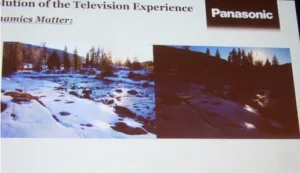Panasonic Hollywood Labs (PHL) was originally a joint venture between Universal Studios and Panasonic, before Panasonic took sole ownership. The organisation moved to a new building in February, which director Ron Martin helped to open.
Martin has been in the entertainment industry for more than 30 years, working with many big names. He told an anecdote about a time when he worked for Lew Wasserman. He was working on Law and Order when he was called into Wasserman’s office and asked to make the studio digital – then Wasserman leaned across the desk and asked, quietly, “By the way…what is digital?” Today, said Martin, Wasserman would probably ask, “What is TV?”
Martin and PHL have had three great realisations when it comes to content: 1) Resolution matters. A lot; 2) Image resolution invites scrutiny – high resolution creates a lean-in experience; and 3) Resolution alone is not enough to carry the evolution of TV. We need more colours, HDR and HFR. PHL is proposing an HDR standard that will fit many different types of content, such as film, TV and so on.
Martin took a moment to talk about HDR on legacy TVs. He said that the content could look terrible on TVs that do not support the format, and so a system is needed that can show HDR on new sets and SDR on older models.
A comparison between SDR (left) and HDR (right) content on a legacy TV screen.HFR is forecast to migrate to 50fps, 60fps and maybe 120fps. In tests, people were shown The Hobbit at 48fps, and said that they disliked it because it “looked like video”. They were then shown the same clip at 24fps, which is the industry standard – and accused Panasonic of breaking the projector! After being assured that 24fps is what they have been watching for their entire lives, the audience unanimously preferred the HFR content.
Based on the three big realisations, PHL came up with three big requirements: 1) Open standards are critical to moving forward; 2) A willingness to break down barriers must be present (Martin commented that 24fps was the absolute best picture that 1925 could produce – but now it’s 2015!); and 3) If collaboration is good, and innovation is desirable, then collaboration that drives innovation is best.
Hewlett asked if we as human beings are more engaged with TV now than we used to be? He remembered watching the 1968 FA Cup Final in black and white, and being more involved than anything since then. Martin said that content is important, of course, but imagery needs a “commitment of excellence” behind it to enable that emotional attachment. Even the news is compelling these days!

